This article is reproduced with permission from the door Venture (thejiangmen) author: Jono MacDougall Translator: Hillsborough song
Magic Leap has always kept the details of their technical work confidential. We now only know that their system is a completely new system and far exceeds all existing competitors that consumers are familiar with. It's no wonder that Magic Leap wants to keep its revolutionary system secret. Numerous companies are waiting to look at the opportunity to understand what technology is, making people so excited.
This kind of technology sounds like what Apple wants to have, the potentially revolutionary "new thing" with true innovation; it is also what Microsoft wants to achieve on Hololens, but it is far from being realized. It is inspired by Google Glass, but it is clearly ahead of generations.
What exactly is this technology and how does it work? I investigated the speeches, patents, job applications, and their backgrounds of people working at Magic Leap, trying to find answers to this question.
In general
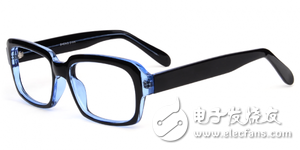
This is regular size glasses. But where is the camera going? Note: This is not a product of Magic Leap.
Before talking about the details, let's talk about what technology is this. Simply put, Magic Leap is working on a device that projects objects into the field of view and is far more realistic than other similar devices we see today. Magic Leap's equipment consists of two parts: a pair of glasses and a portable pocket projector/computing module. This module is a rectangular parallelepiped that is almost the size of a mobile phone. This portable computing module connects the glasses through the data cable. Glasses have similar dimensions and structure to regular glasses, and may be a bit fatter. Small size is an important feature of the product. The small size means that the product can be worn in social situations, and may be as portable and easy to use as a smartphone.
Portable projection and calculation module
As shown, a charging treasure similar in size to the Magic Leap portable module.
The most prominent feature of Magic Leap is the ability to remove a large portion of the necessary hardware from the lens body and place it in a separate module. HoloLens, on the other hand, significantly reduces the size of the various components in the headset, but only to the extent it is today. What's in the portable module? There may be the following sections:
battery
The capacity of this battery is about the same as the current smartphone, and maybe it has to be more. If you want to replace the smart phone, it is a big battery. Estimated to be at least 5,000 mAh.
CPU/GPU
Be sure to use the latest generation of mobile CPUs. It is estimated that Qualcomm will be used. Fortunately, they should not use high-end graphics because Mixed Reality MR only needs to render parts and does not need to render the entire scene. This avoids the high-intensity graphics processing required by Virtual Reality VR.
RAM
Similar to a smartphone, estimated to be 3 - 4 GB.
Custom SLAM chip
This is necessary to place virtual objects in the real world. They may be streaming themselves, or using Movidius or other similar chips.
4G/Wifi/Bluetooth
SIM card
GPS chip
camera
There must be a bunch of cameras on the glasses, but that doesn't mean the portable modules are gone. The SLAM camera on the headset is different from a regular digital camera. The limited size of the glasses may not allow for a high-power camera and can only be placed in a portable module. The advantage of this design is that it can alleviate the concerns of others about privacy violations. Without the portable module, only glasses can't take pictures.
Laser projector
This is the main innovation of the device. The projector system was removed from the glasses and moved to the portable module, resulting in a significant reduction in the size of the product. The projected light is generated by the portable module and then transmitted through the fiber to the headset. Later we will analyze in detail how it works.
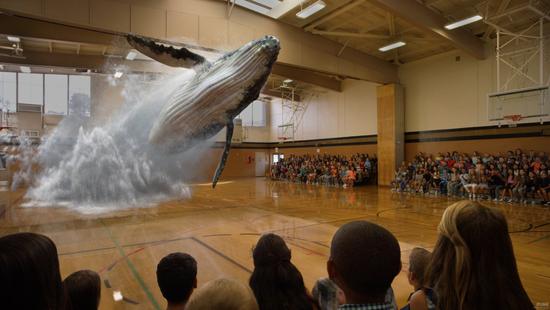
glasses
When we stuff everything into the portable module as much as possible, what is left on the glasses? The following components must be installed on the glasses:
Inertial Measurement Unit (IMU)
Common acceleration sensors, gyroscopes and compasses.
headset
Maybe use the bone conduction headphones on Google Glass. It depends on whether their design ideas are in harmony with the body. The advantage of bone conduction is that you can hear the music played by the headphones while listening to other sounds.
microphone
Optical part
camera
The optical part and camera are the most interesting components, let's analyze it in detail.
Optical part
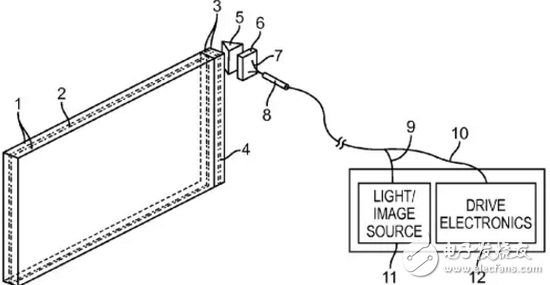
According to the patent literature, the optical devices used by Magic Leap are much smaller than the traditional projection systems used by HoloLens and Google Glass. As shown above, the light source is separate from the body of the headset, which is why we can speculate that the light source is in the portable module. Second, the lens system of the device is also very small. Although the schematic is obviously not drawn to scale, it must also indicate the approximate dimensions of the relevant components. The only component we really see is the lens. Comparing the widths of the 5, 6, 7, and 8 elements and the lens on the upper side of the figure, we can see the relative size.

What does this mean? How can they shrink the optical part so much, and also claim to achieve light field display, high resolution and amazing vision? The answer consists of two parts: a fiber-optic scanning display and a photon light field chip.
Fiber scanning display
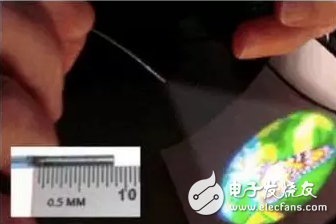
Fiber-optic scanning displays are new display systems that have never been used in consumer electronics. We can only learn through its 2013 patent application documents. This patent application file is some days away, so some details about system performance may be inaccurate, but the basic concepts should be the same. The system uses a set of actuating fibers to scan an image that is much larger than its numerical aperture. It's like an old-fashioned CRT TV. It's just that the output electrons are not scanned to the screen to excite the phosphor, but the output light is scanned directly. Scanning is achieved by piezoelectric actuators. The scanning frequency is maintained at approximately tens of kHz. But the actual image refresh rate is not that high. Because a multiple scan is required (for example, 250 times in the patent), a whole image is generated. This completely changed our concept of resolution. The image resolution of this technique depends on the scanning frequency of the fiber, the minimum spot size at which the fiber can converge (which determines the pixel size), the number of scans required to generate an image, and the refresh frame rate. After considering the patent application, their further optimization of the technology should have a resolution far beyond the existing consumer electronics.
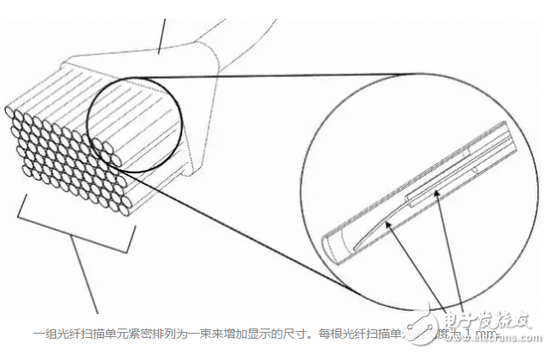
A set of fiber scanning units are closely arranged in a bundle to increase the size of the display. Each fiber scanning unit has a width of 1 mm.
In addition to resolution and frame rate, a wide field of view (FOV) is also the key to displaying realistic holographic images. In this section, the background information section of the patent has a very interesting description.
The field of view of the Head Mounted Display (HMD) can be determined by the image size of the microdisplay and the viewing path. The field of view of the human visual system is about 200° horizontal and about 130° vertical. But most head-mounted displays only provide a field of view of around 40°. ... A radian resolution of approximately 50 - 60 arc seconds represents a 20/20 chart resolution (Translator's Note: Higher eye performance in the visual test standard, see WIKI). The radian resolution is determined by the pixel density of the microdisplay. To match the average human vision system, the head-mounted display should provide 20/20 meter resolution in a 40° horizontal, 40° vertical field of view. Calculated in 50 arc seconds, equivalent to eight megapixels (8 Mpx). If you expand the field of view to 120° horizontally and 80° vertically, you need 50 million pixels (50 Mpx).
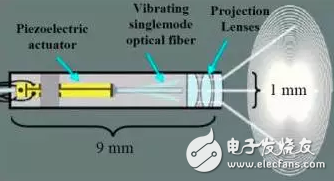
There are two things to talk about here. First, the resolution of consumer-grade displays is much smaller than that required for large fields of view. That's why HoloLens wants to increase the field of view. Second, this shows the ambition of Magic Leap. They want to provide a field of view with a horizontal 120° and a vertical 80°. This field of view is larger than the Oculus Rift's field of view, and the resolution is far superior. Have they achieved it? It's hard to say now, but at least some of the technical parameters have been mentioned in the patent, and don't forget that these are the data three years ago. They are likely to have improved and improved this technology.
The pixel pitch is the distance from the center of one pixel to the center of an adjacent pixel. It limits the resolution of the image. Conventional microdisplays, such as those used by HoloLens, have pixel pitches between 4 and 5 microns. Pixel spacing limits the resolution of these displays and therefore limits the resulting field of view. The patent application documents show that scanning fiber optic displays are capable of generating pixel pitches of 0.6 microns, an order of magnitude higher.
What resolution can I achieve? There is a section in the patent that mentions a resolution of 4375 x 2300, but I think it's more than that. This is an example of a description of the basic method, and the performance improvement of multicore fiber is discussed later. I think its resolution will be much higher than this resolution. This is crucial for a wide field of view.
The last patent mentions the 120° field of view, which is particularly noteworthy:
The above described techniques can be used to fabricate ultra-high resolution displays with a wide field of view for head-mounted or other near-eye display.
I think this is fully verified, and its field of view will be at least 40°, which is not unbelievable. If I want to bet, I bet 90°.
Photon light field chip
The first time I heard that Rony Abovitz gave his lens the name "Photon Light Field Chip", I was depressed. Don't always give some unchanging names to these long-standing things. Just call it Rony lens just fine. But as I gradually deepen my understanding, it is really not a simple lens. What does it do, why is it more interesting than other lenses? Let's first take a look at the diffractive optical components.
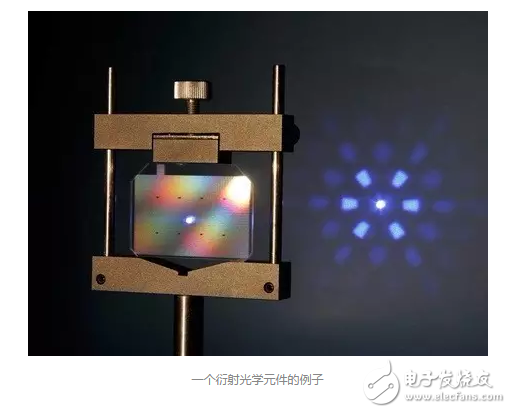
An example of a diffractive optical element
DiffracTIve OpTIcal Elements (DOEs) can be thought of as a very thin set of lenses. They can be used to shape, split, homogenize, and spread. Magic Leap uses a linear diffraction grating with a circular lens to split the light and generate a beam of a specific focal length. That is, it introduces light into your eyes and makes the light appear to be emitted from a correct focal plane. As the saying goes, it is easier said than done, but it is hard to say. At least the patent documents I found are written this way.
To generate the light field, Magic Leap configured a photonic chip using two discrete components. One component (6 in the schematic) extracts the projected light and inserts it into the second component (1 in the schematic), which introduces light into the human eye.
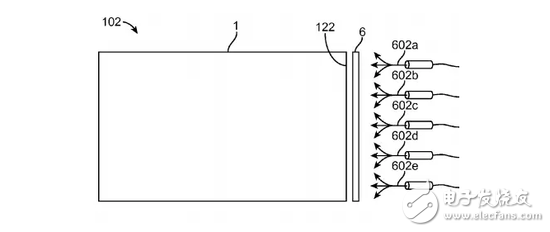
Both components use DOEs to get the job done. The main problem with DOEs is that they can only be used for a specific job after careful debugging. They can't work at different wavelengths and can't change to different focus in real time. To solve this problem, Magic Leap stacked a set of DOEs optimized for different wavelengths and focal planes for use as a large lens set. These DOEs are very thin, with the wavelength of light on a scale, so adding together does not make the device too thick. This is why this optical system is called a chip. Magic Leap is able to switch different layers of DOEs. In this way, they can change the path that light reaches the human eye. This is how they change the focus of the image to form a real light field. As the patent says:
For example, when opening the first of a group of DOEs, an observer with an optical viewing distance of 1 meter can be produced for an observer looking from the front. When a second DOE in a group is turned on, an image with an optical viewing distance of 1.25 meters can be generated.
You might think that this technique is very limited, especially when you need a lot of layers to produce images of different focus, but that's not the case. Combinations of different DOEs can produce different outputs. Not a DOE corresponds to a focal plane, but a DOEs combination corresponds to a focal plane.
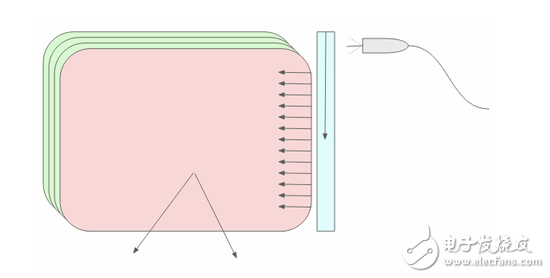
Changing the active layer in the DOEs group changes the light emitted from the photon field chip. They are likely to have many more layers than in the picture, but how many layers are known.
In the end, we understood how Magic Leap achieved its use of light in the past to make darkness. We use an outer DOE and an inner DOE to offset the outside light like an active noise canceling headphone. This is what the patent says:
This can be used to counteract planar optical waveguides like background light or real world light, somewhat similar to active noise canceling headphones.
So why is this a chip? Well, a typical electronic chip changes the flow of electrons based on certain conditions. Magic Leap's photonic field chip changes the photon path based on certain parameters. I think it is also a kind of chip.
What are we missing? We have a photonic field chip with high resolution projection, but how to construct an image. This is by combination. The image is drawn hierarchically so that different parts are projected onto sub-images of different focal lengths. That is to say, each frame is constructed by multiple scans, and each focal plane is drawn separately.

camera
Magic Leap tried to implement three functions on the camera. The first one is the most obvious, a camera that produces everyday images. This is the easiest to understand camera technology they use, and they may be using the latest sensors on the smartphone market. Whether the camera is on the glasses or on the portable module is still unknown, but there is always a photo.
The other two features are very interesting. Magic leap has repeatedly mentioned that its equipment has the ability to understand the world around it. In an interview, it was mentioned that the device recognizes objects such as knives and forks. To do this, they need a set of cameras. We can look at the good HoloLens that I have done in this area. HoloLens has a set of four environment-aware cameras and a depth camera. Further confirmation can be obtained from the patent document of Magic Leap.
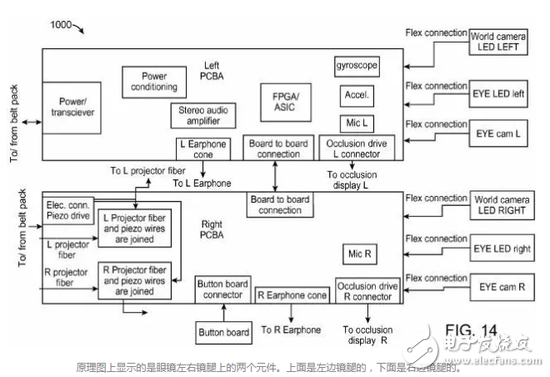
The schematic shows the two components on the left and right temples. The top is the left temple and the bottom is the right temple.
From the above schematic, we can find two outward cameras called "world camera". The textual description of the patent implies that there may be more than two cameras, the original text being "one or more cameras facing each other or providing a world view (each side)". For the time being, I don't know how many cameras there will be, or how small Magic Leap will make these components. But what we know is that these are placed on the glasses and are very important for SLAM.
The function of the last camera can also be found in the schematic above. At least two cameras are needed to shoot the eyes. This is used to track the line of sight and eye movements in order to obtain focus and line of sight. There will also be infrared LEDs that provide illumination for both cameras. Eye tracking is important for user interaction. I think the question "What are you looking at" should be very important for how you interact with Magic Leap. This will be its main interactive tool, like a computer mouse.
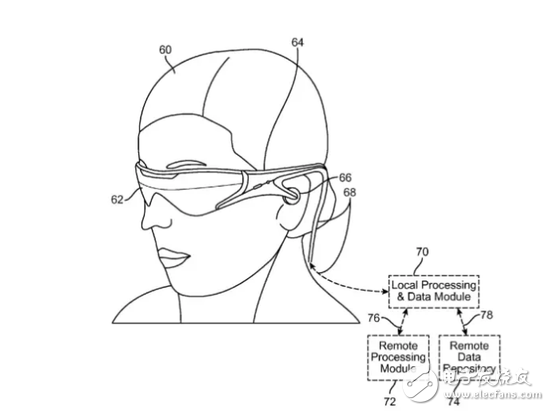
Of course, now, I can't verify whether the information is true or not, but these together add up and really feel like what Magic Leap is doing. Regardless of whether the final product will succeed in the consumer market, this is indeed a true innovation in a technology industry that has not been seen for a while. I am really excited to see what adventures they have, and what kind of impact the product will have on the industry.
CSRME safety controller is developed for standard GB27607. By monitoring machine tool safety related equipment, the security of machine control system can meet the requirements of GB27607, and its security meets the requirements of ISO13849-1 (PLe) and IEC61508 (SIL3).
With rich interfaces, CSRME has limited programmable function. It can simultaneously replace many different types of safety control modules or safety PLCs, thus greatly simplifying the safety design of machine control systems and reducing cost.
Safety Controller,Modular Safety Controller,Safety Controller,Electrical Safety Controller,Programmable Logic Controller,Banner Safety Controller
Jining KeLi Photoelectronic Industrial Co.,Ltd , https://www.sdkelien.com